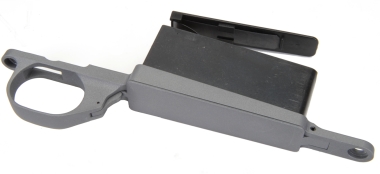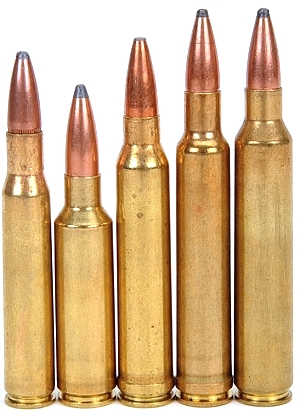
I couldn’t help but think that the Vanguard Series 2 Back Country was a bit of a Vanguard – Mark V Vulcan Mind Meld, drawing the product lines closer together. The Back Country utilizes the alloy steel Vanguard action and 24″ barrel, but the barrel is fluted and the barreled action is finished in durable Tactical Gray Cerakote.
The synthetic stock is more similar to the Mark V Accumark than the Vanguard Griptonite™ synthetic stock; hand-laminated, raised comb, Monte Carlo composite stock with matte gel coat finish and spider web accents. With upgrades, the price tag moves up from the basic Vanguard Synthetic’s $649 MSRP to the Back County’s $1,399 MSRP. However, that bump in price is still a full third less than the Mark V Ultra Lightweight equivalent’s $2,100 MSRP and this has a sub-MOA guarantee.
And with some verbosity…

The Weatherby Vanguard Series 2 Back Country has an alloy steel bolt, knurled knob and twin lugs that yield a 90º lift. The extractor is hinged, which keeps the bolt face clean and the bolt face is recessed to completely contain a cartridge’s case head. The ejector is a plunger type. The bolt body is appropriately vented and light fluting reduces bearing surface and bolt drag.

The bottom metal, the guard and floorplate frame are lightweight aluminum. About what would be expected on a lightweight firearm. The hinged floorplate and latch and magazine box are alloy steel.  The follower is the commonly found poly variety. It all looks and works well and the finish is uniform with the rifle’s other hardware.
The follower is the commonly found poly variety. It all looks and works well and the finish is uniform with the rifle’s other hardware.
The Back Country’s trigger is the 2 stage match quality variety; factory hand honed and tuned for no creep and clean release operation. The trigger is owner adjustable down to 2.5 lbs. The safety is three position.
Working with these assemblies, the parts are cleanly finished, the finish is… cleanly finished and everything operates smoothly and concisely. Another words, there is a quality of design and assembly that follow the price tag.
Taking stock, or schtock, as I often say…
Not a day goes by when the need to use the term “aramid fibers” doesn’t arise… like a big giant pan of biscuits… with butter… and maybe a little gravy. The stock’s composite construction includes: aramid fibers, fiberglass, graphite, epoxy gel coats and laminating resins. Polyurethane reinforcement with milled fiberglass, provides a warm and solid feel rather than the hollow feel associated with injection molded stocks. The spider web effect provides a non-slip surface in addition to providing aesthetic appeal… as any one who has ever looked at or grabbed a spider can testify.


1) the longitudinal speed bumps at the tip of the forearm act as a pressure pad, supporting an otherwise floated barrel. Because the Back Country is a lightweight, the stock does not include an integral aluminum frame. Instead the stock is 2) pillar bedded at both action fastener locations on the flat bottom receiver and also 3) glass bedded at the front which, not coincidentally, the location of the action’s recoil lug 2) & 3).

The Cerakote finish looks good. It has some tooth, so it isn’t a smooth epoxy paint and its ceramic content causes the finish to be elastic in complying with temperature changed surface dimensions, but extremely hard when it comes to resisting scuffing, scratching and chipping. The surface wipes clean. The barrel’s crown is traditional sporter.
|
Weatherby Vanguard Series 2 |
|
| Model | Backcountry |
| Caliber | 300 Weatherby |
| Capacity | 3+1 |
| Stock | Composite Synthetic |
| Hardware Finish | Cerakote |
| Barrel Length | 24″ |
| Twist Rate | 1:10″ |
| Weight | 6.75 lbs |
| Overall Length | 44 1/2″ |
| Pull | 13 5/8″ |
| Drop at comb | 7/8″ |
| Drop at heel | 1 1/4″ |
| Sights | None |
| Trigger Type | Two Stage Adjustable |
| Trigger Pull – Received | 3 lbs. 12 oz. |
| MSRP | $1,399 |
| Typical Retail | Mid – High $1,100 |
|
– |
|
Overall, the Weatherby Vanguard Series 2 Back Country rifle has a good feel, good balance and a good appearance. It comes across as a reliable piece of hardware with looks to install a sense of pride of ownership.
The case for the 300 Weatherby Magnum lightweight…
I’ve been around for so long that I can see a lot of humor in firearm related articles. I’ve lived through the days of Weatherby being called an ultra high velocity flash in the pan and I have lived long enough to see the 300 Weatherby Magnum deemed, by some folks, as under powered for moose hunting. Which is interesting as the cartridge has produced the same power since day one.
The reality is that the 300 Weatherby Magnum is a thumper of a cartridge, only eclipsed by the 300 Remington Ultra Mag and 30-378 Weatherby Magnum as mainstream cartridges. Clearly it is enough for any and all North American game.

Weatherby cartridges are always easy to spot with their venturi type, double radius shoulders and necks. The 300 Weatherby Magnum must have been quite futuristic looking in the mid 1940’s when it was introduced. Pictured left to right in order of case capacity and velocity: 30-06 Springfield, 300 WSM, 300 Winchester Magnum, 300 Weatherby Magnum, 300 Remington Ultra Mag.
Personally, I like the 300 Weatherby. I grew up when it had an aura of high tech ballistic breakthrough. So, today, I carry with me an associated sense of nostalgia. However, beyond nostalgia, there are the perspectives gained from hunting, the target range, chronograph data, and bullet recovery that account for a more pragmatic assessment of the cartridge. It still ranks way up there as a very modern, stellar performer. The substance of Part 2.
We’ll take a break, mount some optics, load some ammunitions and see what this 24″ barrel Vanguard can deliver in 300 Weatherby Magnum power. At six pounds and some in rifle weight, this should be interesting.

Weatherby’s Vanguard Series 2 Back Country Part 1
Weatherby’s Vanguard Series 2 Back Country Part 2

Email Notification